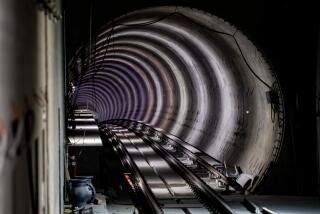When Will the MTA Ever Get on Track? : Problems roll on: Audit turns up thefts, sloppy operations
These are important times for the users and supporters of mass transit in Los Angeles County. The focus of attention must quickly shift to--and remain on--matters of preeminent importance: for example, the issue of how the bus system, subway and rail lines can be made to work together now in a way that best meets the needs of the most people.
Some of the relevant questions are obvious. How can we turn the Green Line into a profitable and popular rail line that serves employees, travelers and neighboring communities? Just how far should the Red Line subway project extend? Should we continue to have a rail system that operates on the honor system? How can we ensure appropriate economic development along the legs of the system? How do we prevent the bus system from coming to resemble something in an undeveloped nation? (Some argue the bus system has already fallen to those depths.)
DAMAGE CONTROL: But while residents and workers in Orange and Riverside counties this month celebrated an important development in regional transportation services--the opening of the nation’s first suburb-to-suburb train line--the focus in Los Angeles remains on the embarrassing and the absurd. And because of that, any serious debate about the direction of the Metropolitan Transportation Authority is again forced to take a back seat to damage control.
What now? An audit by the MTA inspector general showing that the transit agency could be losing millions of dollars each year through dishonest employees, poor management, faulty equipment and more.
The following synopsis will suffice: $1.2 million lost from the theft and improper sale of transfers by a single bus driver; embezzlement of public funds; “numerous cases of thievery in virtually all phases” of MTA operation; revenue so loosely accounted for that management would not know of even large diversions of funds; cash boxes that do not lock; weighing stacks of bills, rather than counting them, when the use of proper counting equipment could save the MTA as much as $426,000 annually; a vault operation described as chaotic (visiting auditors discovered a vault truck driver asleep and two safes left unattended). There’s more, but you probably get the drift.
Some solace might be found in the fact that the MTA has become a little less lukewarm in its response to these problems, but the pattern of such scary tip-of-the-iceberg matters over the years must cause deep concern. All of this damages whatever trust and confidence in the MTA remain. It distracts and discourages and feeds into the growing and nonpartisan sense of the MTA as a cash-cow agency in unchecked disarray.
WHAT, ME WORRY?: Of course, this was the authority that in 1993 had a--shall we say--understated response to the disclosure that the cost of contracts had grown an average of 388% because of routine and unquestioned add-ons: “On the surface, the findings appear troublesome.”
Some of the MTA inspector general’s recommendations growing out of the recent findings have already been implemented, but we cannot help but be worried by an audit that found MTA controls so weak as to expose the agency to huge losses. How many times does the MTA need to be told that one of the nation’s most expensive public works projects requires tight fiscal controls and scrutiny?
Again, there will be the “we’ll do better” press conferences. Again, there will be a chorus of disapproval and dismay. Drastic solutions, such as the idea of putting the MTA’s financial affairs under the control of a trustee, will be resurrected. And properly focusing on how to improve the system will be delayed again.
This week, it’s all aboard once again for the MTA’s expensive “More Thrills Ahead” roller-coaster ride.
More to Read
Sign up for Essential California
The most important California stories and recommendations in your inbox every morning.
You may occasionally receive promotional content from the Los Angeles Times.










